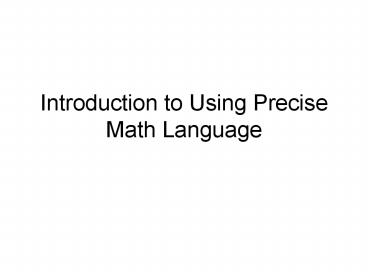Introduction to Using Precise Math Language - PowerPoint PPT Presentation
1 / 18
Title:
Introduction to Using Precise Math Language
Description:
Introduction to Using Precise Math Language What is Using Precise Math Language? Using precise language is a strategy to build a shared understanding of key ... – PowerPoint PPT presentation
Number of Views:101
Avg rating:3.0/5.0
Title: Introduction to Using Precise Math Language
1
Introduction to Using Precise Math Language
2
What is Using Precise Math Language?
- Using precise language is a strategy to build a
shared understanding of key mathematics terms and
symbols. - Students practice using new termsand familiar
terms with new meaningscorrectly to convey ideas
and concepts.
3
Key Elements of Using Precise Math Language
- Students recognize that common words and phrases
can have math-specific meanings. - Students practice using new mathematical terms
and symbols to - Solve problems
- Explain ideas
- Collaborate with peers
- Give feedback
4
How Does Using Precise Math Language Help
Students?
- Expands their mathematics vocabulary and builds
capacity to define/learn new terms. - Supports them in thinking more carefully about
their ideas and their peers ideas. - Enables them to clearly communicate and ask
questions as they solve problems. - Helps them refine their ideas and learn the
importance of precision in language.
5
Discussion Questions 1
- How do you let your students know when precise
mathematical language is needed? - How have you highlighted differences between the
common definitions of words and the math-specific
meanings? - How has precise math language helped your
students in their thinking aloud and solving of
math problems?
6
How Can I Support Student Use of Precise Math
Language?
7
Use Evidence-Based Instructional Practices
- Provide clear explanations
- Use varied examples, materials, and models
- Provide ongoing formative assessment
8
Differentiated Instruction
- Plan instruction that considers students'
readiness, learning needs, and interests. - Use a range of technology tools to
- engage learners at varying levels
- engage learners in multiple ways.
- offer students options for demonstrating
understanding and mastery
9
Teacher-Dependent Ways to Differentiate
- By Content
- Different levels of reading or resource
materials, reading buddies, small group
instruction, curriculum compacting, multi-level
computer programs and Web Quests, audio
materials, etc. - By Product
- Activity choice boards, tiered activities,
multi-level learning center tasks, similar
readiness groups, choice in group work, varied
journal prompts, mixed readiness groups with
targeted roles for students, etc. - By Process
- Tiered products, students choose mode of
presentation to demonstrate learning, independent
study, varied rubrics, mentorships,
interest-based investigations
10
Student-Dependent Ways to Differentiate
- By Readiness
- Options in content, topic, or theme, options in
the tools needed for production, options in
methods for engagement - By Profile
- Consideration of gender, culture, learning
styles, strengths, and weaknesses - By Process
- Identification of background knowledge/gaps in
learning, vary amount of direct instruction, and
practice, pace of instruction, complexity of
activities, and exploration of a topic
11
Discussion Questions 2
- How does using precise math language support the
CCSS Mathematical Practices and the UDL
principles? - How has technology helped you to differentiate
instruction?
12
Provide Clear Expectations Possible Strategies
- Highlight math terms to be used in the lesson.
- When supplying examples and non-examples of
vocabulary words, vary unimportant aspects such
as size, shape, and spatial orientation. - Support students in shaping accurate class
definitions with examples and illustrations for
lesson-specific words.
13
Use Varied Examples, Materials, and Models
Possible Strategies
- Introduce new vocabulary words through
explanations, examples, and illustrations. - Engage your class in discussing and defining
terms use open-ended questions to guide their
work. - Have students update their personal mathematics
glossaries with definitions and illustrations.
14
Provide Ongoing Formative Assessment Possible
Strategies
- Observe small group discussions and activities to
gain a sense of each students progress in
defining and learning new terms. - Ask students to paraphrase what you or other
students have said. - Regularly review students mathematics glossaries
to assess their learning and needs. - When a student uses a new vocabulary word
correctly, point it out (for the benefit of the
whole class, not just that student).
15
Use Online and Offline Tools
- Manipulatives
- Interactive whiteboard
- Web-based applets
- Math drawing tools
- Calculators
- 3D design software
- Graphing and charting software
16
Use Evidence-Based Strategies and Tools
- To launch the lesson
- During the learning task
- As you bring closure to the lesson
17
Discussion Questions 3
- What challenges have your students faced when
learning new math terms? - Are there models or visual representations that
you have found useful when introducing precise
math language? - What technology tools have you used to support
formative assessment?
18
Disclaimer
- Awarded through a cooperative agreement from the
U.S. Department of education, Office of Special
Education Programs (OSEP), Grant H327G090004-10,
PowerUp What Works was developed by a team of
experts in education, technology, differentiated
instruction/UDL, and special education at the
Center for Technology Implementation, operated by
the American Institutes for Research (AIR) in
collaboration with the Education Development
Center, Inc. (EDC) and the Center for Applied
Special Technology (CAST). - This document contains information from other
public and private organizations that may be
useful to the reader these materials are merely
examples of resources that may be available.
Inclusion of this information does not constitute
an endorsement by the U.S. Department of
Education of any products or services offered or
views expressed. This publication also contains
hyperlinks and URLs created and maintained by
outside organizations and provided for the
reader's convenience. The Department is not
responsible for the accuracy if this information.
Further, the programs/models/resources featured
on this site have not been extensively evaluated
by CTI. This website was created and is
maintained by American Institutes for Research
(AIR) through funding from the U.S. Department of
Education, Award H327G090004. For more
information, send an e-mail to PowerUp_at_air.org.































